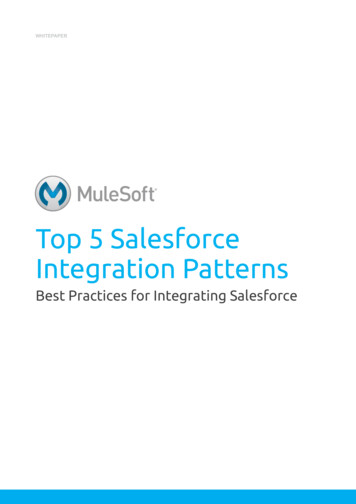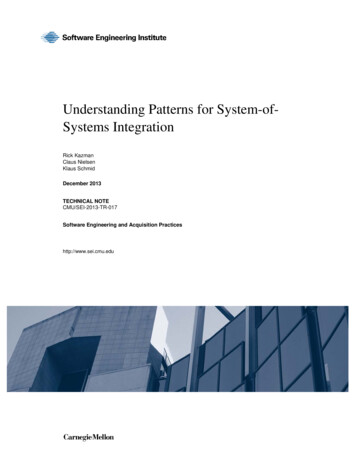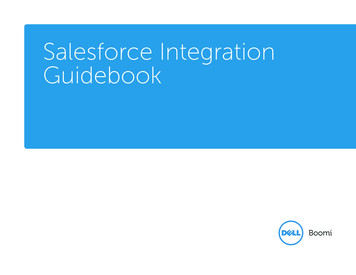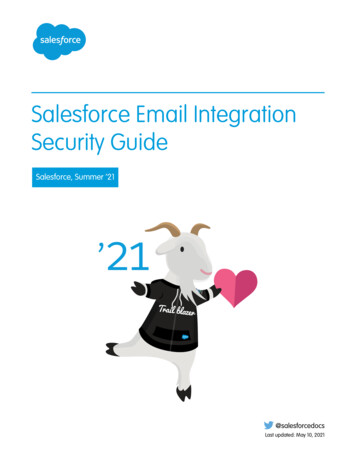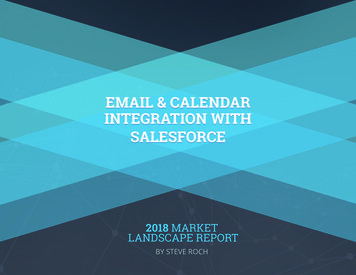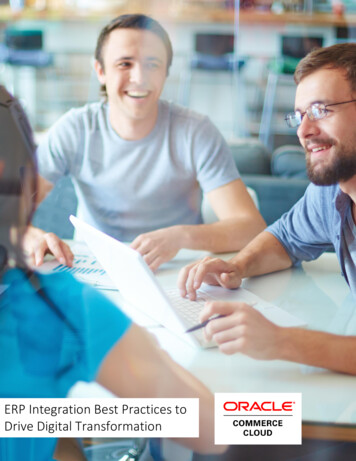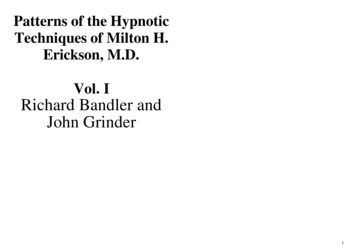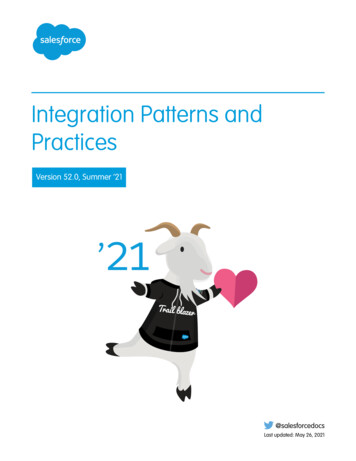
Transcription
Integration Patterns andPracticesVersion 52.0, Summer ’21@salesforcedocsLast updated: May 26, 2021
Copyright 2000–2021 salesforce.com, inc. All rights reserved. Salesforce is a registered trademark of salesforce.com, inc.,as are other names and marks. Other marks appearing herein may be trademarks of their respective owners.
CONTENTSINTRODUCTION.1Chapter 1: Integration Patterns Overview . . . . . . . . . . . . . . . . . . . . . . . . . . . . . . . . . . . 1Purpose and Scope . . . . . . . . . . . . . . . . . . . . . . . . . . . . . . . . . . . . . . . . . . . . . . . . . . . . 1Pattern Template . . . . . . . . . . . . . . . . . . . . . . . . . . . . . . . . . . . . . . . . . . . . . . . . . . . . . . 1Pattern Summary . . . . . . . . . . . . . . . . . . . . . . . . . . . . . . . . . . . . . . . . . . . . . . . . . . . . . . 2Pattern Approach . . . . . . . . . . . . . . . . . . . . . . . . . . . . . . . . . . . . . . . . . . . . . . . . . . . . . 3Pattern Selection Guide . . . . . . . . . . . . . . . . . . . . . . . . . . . . . . . . . . . . . . . . . . . . . . . . . . 3Middleware Terms and Definitions . . . . . . . . . . . . . . . . . . . . . . . . . . . . . . . . . . . . . . . . . . 5DESIGN PATTERN CATALOG . . . . . . . . . . . . . . . . . . . . . . . . . . . . . . . . . . . . . . . . 9Chapter 2: Remote Process Invocation—Request and Reply . . . . . . . . . . . . . . . . . . . . 9Chapter 3: Remote Process Invocation—Fire and Forget . . . . . . . . . . . . . . . . . . . . . . 16Chapter 4: Batch Data Synchronization . . . . . . . . . . . . . . . . . . . . . . . . . . . . . . . . . . . 28Chapter 5: Remote Call-In . . . . . . . . . . . . . . . . . . . . . . . . . . . . . . . . . . . . . . . . . . . . . 35Chapter 6: UI Update Based on Data Changes . . . . . . . . . . . . . . . . . . . . . . . . . . . . . 47Chapter 7: Data Virtualization . . . . . . . . . . . . . . . . . . . . . . . . . . . . . . . . . . . . . . . . . . 50APPENDICES. . . . . . . . . . . . . . . . . . . . . . . . . . . . . . . . . . . . . . . . . . . . . . . . . . . . . 58Appendix A: Resources—External . . . . . . . . . . . . . . . . . . . . . . . . . . . . . . . . . . 58Appendix B: Resources—Salesforce . . . . . . . . . . . . . . . . . . . . . . . . . . . . . . . . 59Appendix C: Security Considerations . . . . . . . . . . . . . . . . . . . . . . . . . . . . . . . . 60Appendix D: Event Driven Architecture . . . . . . . . . . . . . . . . . . . . . . . . . . . . . . 62
INTRODUCTIONCHAPTER 1Integration Patterns OverviewWhen you implement Salesforce, you frequently need to integrate it with other applications. Although each integration scenario isunique, there are common requirements and issues that developers must resolve.This document describes strategies (in the form of patterns) for these common integration scenarios. Each pattern describes the designand approach for a particular scenario rather than a specific implementation. In this document you’ll find: A number of patterns that address key “archetype” integration scenarios A selection matrix to help you determine which pattern best fits your scenario Integration tips and best practicesPurpose and ScopeThis document is for designers and architects who need to integrate the Lightning Platform with other applications in their enterprise.This content is a distillation of many successful implementations by Salesforce architects and partners.Read the pattern summary and selection matrix if you’re considering large-scale adoption of Salesforce-based applications (or theLightning Platform) to become familiar with the integration capabilities and options available. Architects and developers should considerthese pattern details and best practices during the design and implementation phase of a Salesforce integration project.If implemented properly, these patterns enable you to get to production as fast as possible and have the most stable, scalable, andmaintenance-free set of applications possible. Salesforce’s own consulting architects use these patterns as reference points duringarchitectural reviews and are actively engaged in maintaining and improving them.As with all patterns, this content covers most integration scenarios, but not all. While Salesforce allows for user interface (UI)integration—mashups, for example—such integration is outside the scope of this document. If you feel that your requirements areoutside the bounds of what these patterns describe, speak with your Salesforce representative.Pattern TemplateEach integration pattern follows a consistent structure. This provides consistency in the information provided in each pattern and alsomakes it easier to compare patterns.NameThe pattern identifier that also indicates the type of integration contained in the pattern.ContextThe overall integration scenario that the pattern addresses. Context provides information about what users are trying to accomplish andhow the application will behave to support the requirements.1
Integration Patterns OverviewPattern SummaryProblemThe scenario or problem (expressed as a question) that the pattern is designed to solve. When reviewing the patterns, read this sectionto quickly understand if the pattern is appropriate for your integration scenario.ForcesThe constraints and circumstances that make the stated scenario difficult to solve.SolutionThe recommended way to solve the integration scenario.SketchA UML sequence diagram that shows you how the solution addresses the scenario.ResultsExplains the details of how to apply the solution to your integration scenario and how it resolves the forces associated with that scenario.This section also contains new challenges that can arise as a result of applying the pattern.SidebarsAdditional sections related to the pattern that contain key technical issues, variations of the pattern, pattern-specific concerns, and soon.ExampleAn end-to-end scenario that describes how the design pattern is used in a real-world Salesforce scenario. The example explains theintegration goals and how to implement the pattern to achieve those goals.Pattern SummaryThe following table lists the integration patterns contained in this document.List of PatternsPatternScenarioRemote ProcessInvocation—Request and ReplySalesforce invokes a process on a remote system, waits for completion of that process, and thentracks state based on the response from the remote system.Remote Process Invocation—Fire Salesforce invokes a process in a remote system but doesn’t wait for completion of the process.and ForgetInstead, the remote process receives and acknowledges the request and then hands off controlback to Salesforce.2
Integration Patterns OverviewPattern ApproachPatternScenarioBatch Data SynchronizationData stored in Lightning Platform is created or refreshed to reflect updates from an external system,and when changes from Lightning Platform are sent to an external system. Updates in eitherdirection are done in a batch manner.Remote Call-InData stored in Lightning Platform is created, retrieved, updated, or deleted by a remote system.UI Update Based on Data Changes The Salesforce user interface must be automatically updated as a result of changes to Salesforcedata.Data VirtualizationSalesforce accesses external data in real time. This removes the need to persist data in Salesforceand then reconcile the data between Salesforce and the external system.Pattern ApproachThe integration patterns in this document are classified into three categories: Data Integration—These patterns address the requirement to synchronize data that resides in two or more systems so that bothsystems always contain timely and meaningful data. Data integration is often the simplest type of integration to implement, butrequires proper information management techniques to make the solution sustainable and cost effective. Such techniques ofteninclude aspects of master data management (MDM), data governance, mastering, de-duplication, data flow design, and others. Process Integration—The patterns in this category address the need for a business process to leverage two or more applications tocomplete its task. When you implement a solution for this type of integration, the triggering application has to call across processboundaries to other applications. Usually, these patterns also include both orchestration (where one application is the central“controller”) and choreography (where applications are multi-participants and there is no central “controller”). These types ofintegrations can often require complex design, testing, and exception handling requirements. Also, such composite applicationsare typically more demanding on the underlying systems because they often support long-running transactions, and the ability toreport on and/or manage process state. Virtual Integration—The patterns in this category address the need for a user to view, search, and modify data that’s stored in anexternal system. When you implement a solution for this type of integration, the triggering application has to call out to otherapplications and interact with their data in real time. This type of integration removes the need for data replication across systems,and means that users always interact with the most current data.Choosing the best integration strategy for your system isn’t trivial. There are many aspects to consider and many tools that can be used,with some tools being more appropriate than others for certain tasks. Each pattern addresses specific critical areas including the capabilitiesof each of the systems, volume of data, failure handling, and transactionality.Pattern Selection GuideThe selection matrix table lists the patterns, along with key aspects, to help you determine the pattern that best fits your integrationrequirements. The patterns in the matrix are categorized using the following dimensions:AspectDescriptionSource/TargetSpecifies the requester of the integration transaction along with the target(s) that provide theinformation. Note that the technical capabilities of the source and target systems, coupled withthe type and timing of the integration, may require an additional middleware or integration solution.See the details of each pattern for more details.3
Integration Patterns OverviewPattern Selection GuideAspectDescriptionTypeSpecifies the style of integration: Process, Data, or Virtual. Process—Process-based integrations can be defined as ways to integrate the processing offunctional flow across two or more applications. These integrations typically involve a higherlevel of abstraction and complexity, especially for transactionality and rollback. Data—Data integrations can be defined as the integration of the information used byapplications. These integrations can range from a simple table insert or upsert, to complex dataupdates requiring referential integrity and complex translations. Virtual—Virtual integration can be defined as the integration where Salesforce is able to interactwith data that resides in an external system without the need to replicate the data withinSalesforce. This type of integration is always triggered through an event from the Salesforceplatform, for example, a user action, workflow, search, updating a record, resulting in dataintegration with an external source in real time.TimingSpecifies the blocking (or non-blocking) nature of the integration. Synchronous—Blocking or “near-real-time” requests can be defined as “request/responseoperation, and the result of the process is returned to the caller immediately via this operation.”1 Asynchronous—Non-blocking, queue, or message-based requests are “invoked by a one-wayoperation and the results (and any faults) are returned by invoking other one-way operations.”2The caller therefore makes the request and continues, without waiting for a response.Note: An integration can require an external middleware or integration solution (for example, Enterprise Service Bus) dependingon which aspects apply to your integration scenario.Pattern Selection MatrixThe following table lists the patterns, along with key aspects, to help you determine the pattern that best fits your integration requirements.Source/TargetTypeTimingKey Patterns to ConsiderProcessDataVirtualSynchronous AsynchronousIntegration Integration IntegrationSalesforce – SystemXXRemote Process Invocation—Requestand ReplyXXXRemote Process Invocation—Requestand ReplyX12Remote Process Invocation—Fire andForgetUI Update Based on Data Changes“Synchronous vs. Asynchronous Communication in Applications Integration,” MuleSoft, last accessed May 18, ations-integration.Ibid.4
Integration Patterns OverviewMiddleware Terms and DefinitionsSource/TargetTypeTimingKey Patterns to ConsiderProcessDataVirtualSynchronous AsynchronousIntegration Integration IntegrationXSystem – SalesforceXXData VirtualizationXRemote Call-InXXXRemote Call-InRemote Call-InXBatch Data SynchronizationMiddleware Terms and DefinitionsThis table lists some key terms related to middleware and their definitions with regards to these patterns.TermDefinitionEvent handlingEvent handling is the receipt of an identifiable occurrence at a designated receiver (“handler”). Thekey processes involved in event handling include: Identifying where an event should be forwarded. Executing that forwarding action. Receiving a forwarded event. Taking some kind of appropriate action in response, such as writing to a log, sending an erroror recovery process, or sending an extra message.Keep in mind that the event handler might ultimately forward the event to an event consumer.Common uses of this feature with middleware can be extended to include the popular“publish/subscribe” or “pub/sub” capability. In a publish/subscribe scenario, the middleware routesrequests or messages to active data-event subscribers from active data-event publishers. Thesec
22.04.2021 · CHAPTER 1 Integration Patterns Overview When you implement Salesforce, you frequently need to integrate it with other applications. Although each integration scenario is unique, there are common requirements and issues that developers must resolve. This document describes strategies (in the form of patterns) for these common integration scenarios. Each pattern describes the design
